Race track
A race track (or "racetrack", "racing track" or "racing circuit") is a facility built for racing of vehicles, athletes, or animals (e.g. horse racing or greyhound racing). A race track also may feature grandstands or concourses. Race tracks are also used in the study of animal locomotion. Some motorsport tracks are called speedways.

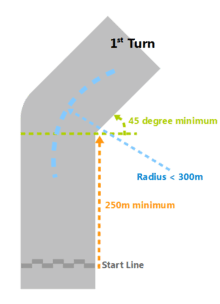

A racetrack is a permanent facility or building. Racecourse is an alternate term for a horse racing track, found in countries such as the United Kingdom, India, Australia, Hong Kong, and the United Arab Emirates. Race tracks built for bicycles are known as velodromes. Circuit is a common alternate term for race track, given the circuit configuration of most race tracks, allowing races to occur over several laps.
A race course, as opposed to a racecourse, is a nonpermanent track for sports, particularly road running, water sports, road racing, or rallying. Many sports usually held on race tracks also can occur on temporary tracks, such as the Monaco Grand Prix in Formula One.
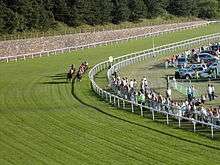
History
Some evidence remains of racetracks being developed in several ancient civilizations. The most developed ancient race tracks were the hippodromes of the Ancient Greeks and the circuses (circi) of the Roman Empire. Both of these structures were designed for horse and chariot racing. The stadium of the Circus Maximus in Ancient Rome could hold 200,000 spectators.
Racing facilities existed during the Middle Ages, and records exist of a public racecourse being opened at Newmarket in London in 1174. In 1780, the Earl of Derby created a horse-racing course on his estate at Epsom; the English Derby continues to be held there today. Racecourses in the British Isles are based on grass, known as turf tracks. In the United States, the race tracks are soil.
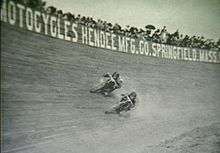
With the advent of the automobile in the late 19th and early 20th centuries, race tracks were designed to suit the nature of powered machines. The earliest tracks were modified horse-racing courses. Racing automobiles in such facilities began in September 1896, at Narragansett Park in Cranston, Rhode Island. The Indianapolis Motor Speedway was opened in August 1909.
Beginning in the early 1900s, motorcycle races were run on high, banked, wooden race tracks called board tracks. During the 1920s, many of the races on the AAA Championship circuit were run on such board tracks. Modern racetracks are designed with spectator safety being paramount, following incidents of spectator and track marshals fatalities. These often involve run-off areas, barriers, and high fencing.
Sports


Racetracks are used for:
Animal sports
Human sports
Motor sports
- Auto racing
- Drag racing
- Kart racing
- Motorcycle racing
- Stock car racing
- Track racing (motorcycles)
- Truck racing
- Drift racing
Configurations

Some racetracks offer little in the way of permanent infrastructure other than the track; others incorporate spectator facilities such as grandstands, hospitality or facilities for competitors, such as pit lanes and garages, paddocks and stables. Several racetracks are incorporated into larger venues or complexes, incorporating golf courses, museums, hotels, and conference centres. Some racetracks are small enough to be contained indoors, for sports such as motocross, cycling, and athletics.
Many racetracks are multi-use, allowing different types of sport on the same track, or incorporating many tracks in one venue. Commonly running tracks are incorporated within general use or soccer stadiums, either permanently visible or covered by stands or pitches.
Many horse and motorsport tracks are configurable, allowing different routes or sections. Some venues contain smaller tracks inside larger ones, with access tunnels and bridges for spectators. Some racetracks incorporate a short course and a longer course which uses part of the shorter one, usually the main straight, such as Brands Hatch. The Le Mans road race venue is centred on a smaller permanent circuit within its complex.
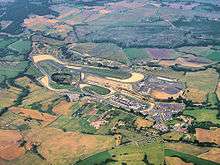
Surfaces

Surfaces include:
- All-weather running track (Tartan) (athletics)
- Artificial turf (electric radio controlled off-road racing)[1][2]
- Asphalt/tarmac (motorsport, athletics, cycling)
- Carpet (electric radio controlled racing)[3][4]
- Concrete (motorsport)
- Dirt (horses, greyhound, automobiles, motorbike (track racing), stock car, radio controlled off-road racing, cycling)
- Grass (horses, amateur motorsport, cross country running)
- Ice (Ice racing – when on dirt tracks, Bobsleigh, speed skating, ice motor racing)
- Sand (horse, camel, greyhound, rally raid)
- Wood (cycling) (board track racing – now defunct)
Motorsport
Race tracks are primarily designed for road racing competition through speed, featuring defined start-finish lines or posts, and sometimes even a series of defined timing points that divide the track into time sectors. Some sports merely measure endurance, or how long a competitor can race. Race tracks can host individual or team sports. Racetracks can feature rolling starts, or fixed starts, with associated equipment (starting blocks, cages, wheel traps etc.) They invariably feature a pit lane, and usually timing equipment.
Track layout
Some race tracks are of an oval shape, and can be banked, which allows almost universal spectator views or high speed racing (cycling, stock cars). A famous one is Nardò where high-speed manufacturer testing often takes place, and the Indianapolis Motor Speedway. Some oval tracks are variations on an oval shape, for practical reasons or to introduce varying difficulties such as Talladega (a tri-oval). Most race tracks have meandering circuits with many curves, chicanes and changes in height, to allow for a challenge in skill to the competitors, notably motocross and touring car racing – these tend to predominate throughout most of the world, but especially in Europe.
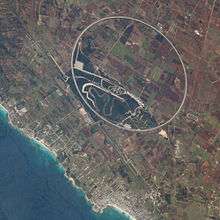
Road circuits
Flatter meandering motorsport courses are sometimes called 'road circuits', originating in the fact that the earliest road racing circuits were simply closed-off public roads. True road circuits are still in use, e.g. the Australian GP has been run in Adelaide and continues to be in Melbourne on regular city streets. The most famous of these are the Monaco GP, and the Spa-Francorchamps circuit in Belgium. Some racetracks are specifically configured in a long straight, namely drag racing. Some races will be held only over the straight portion of a track (some horse racing and sprint athletics).
Converted airfields
After World War 2, many wartime airfields, particularly in Great Britain, were left without further use. This coincided with a post-war boom in motorsport, and many airfields were converted to race tracks, where the circuit layout usually combined parts of the runways and the surrounding perimeter taxiways. The famous British track at Silverstone is a former Class A airfield, as are Castle Combe and Goodwood. The long runways were perfect for drag strips such as at Santa Pod Raceway. This type of track also appears on the popular motoring show Top Gear, which is filmed at Dunsfold Aerodrome, in Surrey, England.
Books about race tracks
In 2015, Maurice Hamilton published Grand Prix Circuits: Maps and Statistics From Every Formula One Track, which covers over 70 Grand Prix racing circuits. It provides maps, pictures, and a brief history of each track.[5] Each course map is accompanied by statistics including circuit lengths, lap records, and the names of corners and straights.
See also
- Animal locomotion
- Auto racing
- List of motor racing circuits by FIA Grade
- List of auto racing tracks in the United States
- List of horse racing venues
References
- "2015 IFMAR Yatabe Worlds: Astrogate". Archived from the original on 4 March 2016. Retrieved 29 December 2015.
- http://news.efra.ws/fileadmin/news/2014/12/Result%20postal%20vote%20November%20Electric%20IFMAR2014&Datechange%20%281%29.pdf Archived 2015-02-18 at the Wayback Machine
- "The track surface for 1/12th Class is recommended to be indoors on standardised needle carpet." IFMAR Electric Track Racing and Technical Rules Archived 2014-08-22 at the Wayback Machine
- 2013 ROAR Rulebook Archived 2015-08-17 at the Wayback Machine p. 14
- Maurice, Hamilton (2015). Grand Prix Circuits: History and Course Map For Every Formula One Circuit. London. ISBN 9780008136604. OCLC 951146691.
External links
| Wikimedia Commons has media related to Racing circuits. |
- trackpedia.com Worldwide Motor Racing track wiki
- racingcircuits.net Worldwide Motor Racing track database
- When the going gets rough – tyres and track surfaces
- AudioTrackGuides.co.uk Audio walkthroughs of motor racing circuits, for use with games.
- Trackreviewers.com Motorsport Track Reviews and Information